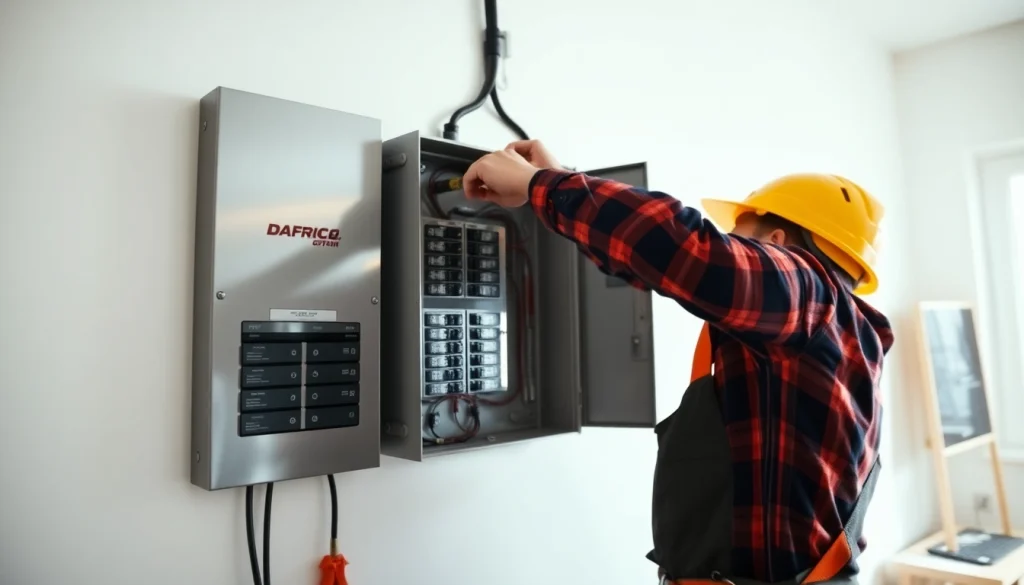Understanding the Electrical Panel: What You Need to Know
1. Definition and Purpose of an Electrical Panel
An electrical panel, commonly known as a breaker box or distribution board, is a critical component of any electrical system in a home or commercial building. It serves as the central hub where electrical power is distributed to various circuits within the structure. The primary purpose of an electrical panel is to protect the circuits from overload by breaking the circuit when too much current flows through. Each circuit connects to a circuit breaker or fuse, which automatically disconnects the circuit in case of a fault, helping to prevent electrical fires and equipment damage. This Electrical Panel therefore ensures both safety and efficiency within electrical systems.
2. Components of an Electrical Panel
The efficiency and safety of an electrical panel depend on several key components:
- Main Breaker: This is the first point of disconnect for the entire system, serving as a safety switch that can shut off power to all circuits.
- Circuit Breakers: These are switches that protect individual circuits by disconnecting power when a fault or overload occurs.
- Buses: Conductors that distribute power to various circuit breakers within the panel.
- Grounding System: Helps prevent electrical shock and damage by redirecting excess electrical current to the ground.
- Neutral Bus Bar: This component serves as the return path for currents, completing the electrical circuit.
3. Importance of a Functional Electrical Panel
A functional electrical panel is vital for a safe and efficient electrical system. It acts as the nerve center of your electrical installation, managing how power flows throughout your home. A properly working panel ensures that electrical demands are met without exceeding capacity, thus preventing overheating and potential electrical fires. Furthermore, an updated or modern panel can accommodate newer technologies and devices that require higher amperage, enhancing the overall electrical safety and efficiency of the building.
Signs That Indicate You Need to Upgrade Your Electrical Panel
1. Frequent Circuit Breaker Trips
If you notice that the circuit breakers in your electrical panel trip frequently, it could be a sign of an overloaded circuit or an outdated electrical panel struggling to meet current demands. Constant tripping is an indication that your panel needs an upgrade to handle the load of modern appliances and electronics.
2. Overheating and Burn Marks
Overheating within the panel can lead to dangerous situations. If you observe heat emanating from the panel or visible burn marks on it, this could indicate faulty wiring or connections that may start a fire. Immediate inspection and potential replacement of the panel are crucial in such cases.
3. Outdated Electrical Panel Types
Older electrical panels, such as fuse boxes, often lack the safety and capacity features present in modern circuit breaker panels. If your home features an outdated electrical panel, it’s time to consider an upgrade to improve both safety and functionality.
Evaluating Your Home’s Electrical Needs
1. Assessing Total Electricity Demand
Understanding the total electricity demand of your home is essential in evaluating whether your electrical panel is adequate. Begin by calculating the total wattage of all appliances, lights, and systems that will run simultaneously. This total demand will indicate whether your current panel meets your needs or if it requires an upgrade.
2. Understanding Amperage Requirements
Electrical panels commonly come in various amperage ratings, such as 100, 200, or even 400 amps. The amperage requirement of your home depends on the number of circuits and electrical load. Homes with modern appliances, such as electric stoves and HVAC systems, typically require at least a 200-amp service.
3. Future-Proofing Your Home’s Electrical System
When upgrading your electrical panel, consider future-proofing your electrical system. Anticipate potential increases in power demand as technology advances and more devices are introduced into the home. Installing a panel with higher capacity than what you currently need can save you money in the long run and ensure you can easily accommodate future upgrades.
Choosing the Right Electrical Panel for Your Home
1. Comparing Top Brands and Models
There are various brands and models of electrical panels on the market, each with unique features and specifications. Brands like Square D, Eaton, and Siemens are known for their reliability and are widely used in residential settings. When comparing options, look for panels that offer excellent safety features, warranty, and compatibility with future technologies.
2. Assessing Installation Costs
The cost of installing a new electrical panel can vary depending on several factors, including the type of panel, the complexity of the installation, and local labor rates. On average, homeowners should expect to spend between $1,200 to $2,500 for a complete upgrade, including parts and labor. It’s vital to get quotes from multiple electricians to ensure you’re receiving a competitive price.
3. Professional vs. DIY Installation
While installing an electrical panel can be a DIY project for seasoned homeowners, it is highly recommended to hire a licensed electrician for safety and compliance with local codes. Professionals ensure that the installation is up to code, significantly reducing the risk of electrical hazards. Additionally, many insurance companies require professional installation for coverage in case of electrical failures.
Maintenance and Lifespan of Electrical Panels
1. Regular Inspections and Upkeep
Regular inspections of your electrical panel are crucial to maintaining its functionality and safety. Schedule an annual inspection with a certified electrician to check for signs of wear, overheating, or corrosion. Early detection of issues can prevent more significant problems and extend the lifespan of your panel.
2. Recognizing Signs of Deterioration
Look for warning signs indicating your panel may be deteriorating, such as rust, moisture, or strange noises during operation. Electrical panels should be in good condition, and any signs of damage should be addressed immediately to prevent safety hazards.
3. Planning for Long-Term Safety
Planning for long-term safety involves not just addressing current electrical needs but also anticipating future upgrades and changing requirements within the home. Ensure your electrical panel is loaded correctly, considering potential usage changes over time. A future-oriented approach to electrical panel maintenance and replacement can provide peace of mind and enhance home safety.








